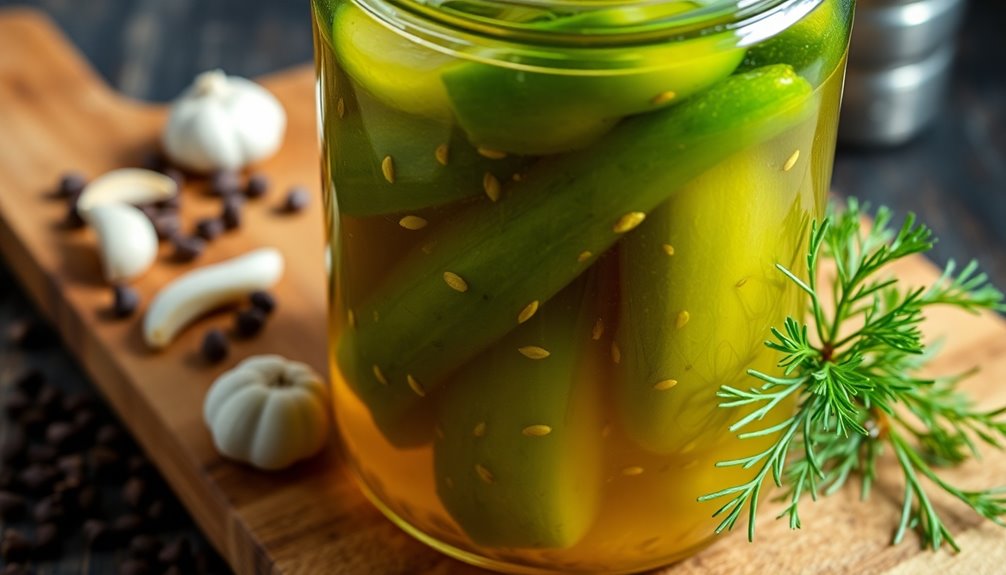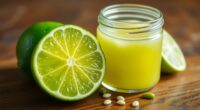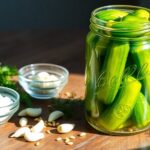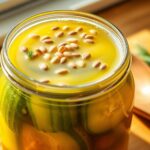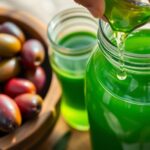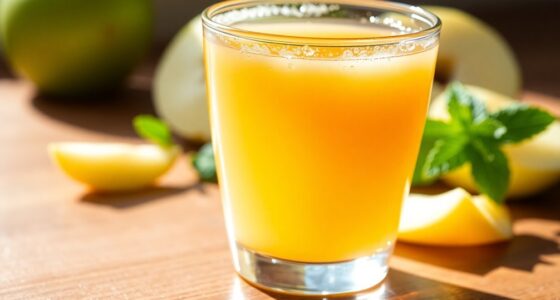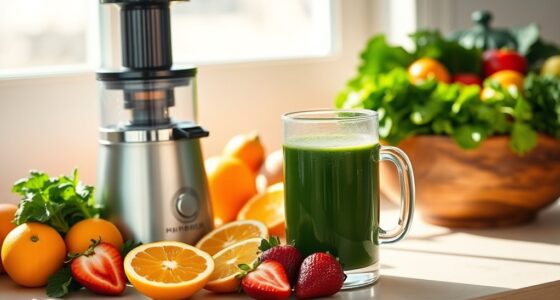To make pickle juice, combine 2 cups of water and 1 cup of white vinegar in a saucepan. Add 2 tablespoons of kosher salt and an optional tablespoon of sugar. Heat the mixture until the salt and sugar dissolve, then let it cool. Once cooled, submerge your cucumber slices in the brine and refrigerate for a few days. Homemade pickle juice is preservative-free and customizable, making it a great addition to your culinary adventures. You’ll discover even more tips ahead! To enhance your pickling skills, you might also be interested in how to prepare cabbage juice for a tangy twist on traditional recipes. Simply blend fresh cabbage with a bit of water and strain the mixture to extract the juice, which can add a unique flavor to your brine. Experimenting with different vegetables and flavorings will allow you to create a variety of pickled treats that suit your taste preferences perfectly.
Key Takeaways
- Combine 2 cups of water and 1 cup of white vinegar in a medium saucepan.
- Add 2 tablespoons of kosher salt and optional sugar for sweetness.
- Heat the mixture over medium-high until the salt and sugar dissolve completely.
- Allow the brine to cool before using to prevent cooking vegetables.
- Submerge cucumbers in the cooled brine and refrigerate for several days to pickle.

Making your own pickle juice is easier than you might think, and it opens up a world of flavor for your pickling adventures. You don't need fancy ingredients or extensive cooking skills to whip up a homemade version. With just a few simple items, you can create a delicious brine that's perfect for pickling cucumbers or enhancing other dishes.
To get started, gather your ingredients. You'll need 2 cups of purified or filtered water, 1 cup of white vinegar, 2 tablespoons of kosher salt, and optionally, 1 tablespoon of pickling spice and a dash of sugar. These components work together to create that signature pickle juice flavor you love. If you like a slightly sweeter brine, adding sugar can help balance the acidity of the vinegar.
Next, grab a medium saucepan and pour in the water and white vinegar. The vinegar you choose should ideally have 5% acetic acid, which is the standard for most pickling recipes. Then, add the kosher salt, which is crucial for flavor and preservation. Stir the mixture over medium-high heat until the salt and sugar fully dissolve. This step is important, as it ensures that your pickle brine has a smooth consistency without any gritty texture.
Once everything is dissolved, remove the saucepan from the heat and let the mixture cool. This cooling period is essential because it prevents any potential cooking of your vegetables if you're planning to use the brine immediately. If you're into experimenting, consider adding dill sprigs or other herbs to the brine during the cooling process for an extra layer of flavor.
Now you've got your homemade pickle juice ready to go. Use it to pickle cucumbers by submerging the slices in the brine and letting them sit in the refrigerator for a few days. You'll be amazed at how quickly they transform into delicious pickles. And if you're not in the mood for pickling, you can also drink the pickle juice directly for its potential health benefits, like relieving cramps.
One of the advantages of making your own pickle juice is that it's preservative-free and you can customize it to your taste. Unlike store-bought varieties, which often contain additives, your homemade version is pure and packed with flavor. Plus, once you've made a batch, you can store it in sterilized jars in the refrigerator, where it can last for several months.
The versatility of pickle juice doesn't stop at pickling cucumbers. You can use it to enhance salads, marinades, or even as a tangy addition to cocktails. So, next time you think about reaching for that store-bought jar, remember that making your own pickle juice isn't only simple but also a fun way to elevate your culinary creations. Enjoy the process and savor the delicious results!
Frequently Asked Questions
What Are the Ingredients in Pickle Juice?
When you're curious about the ingredients in pickle juice, you'll find that it typically includes purified water, white vinegar, and kosher salt.
These elements create the classic tangy brine. You might also consider adding optional ingredients like pickling spices, garlic, or a dash of sugar to balance the acidity.
The basic ratio usually involves 2 cups of water, 1 cup of vinegar, and 2 tablespoons of salt for a delicious, flavorful mix.
How to Make Pickle Solution at Home?
To make a pickle solution at home, you'll need a saucepan.
Start by combining two cups of purified water with one cup of white vinegar.
Add two tablespoons of kosher salt and one tablespoon of pickling spice, stirring until the salt dissolves.
If you want a touch of sweetness, sprinkle in a dash of sugar.
Bring it to a boil, then let it cool before storing it in an airtight container.
Can I Make My Own Pickle Juice for Leg Cramps?
Ever found yourself in the middle of a workout, suddenly gripped by a leg cramp?
You'll be glad to know you can make your own pickle juice to combat that! Just grab some purified water, white vinegar, kosher salt, and pickling spice.
Mix them up, and you've got a quick remedy. This homemade solution packs electrolytes, helping you bounce back faster.
How to Make Pickling Juice?
To make pickling juice, you'll need a few simple ingredients.
Start with 2 cups of purified water and 1 cup of white vinegar, ensuring it has at least 5% acidity. This mixture can be a useful solution for cleaning purposes or for a natural deodorizer around your home. However, if you find yourself with leftover vape juice that you need to dispose of, it’s important to know how to safely dump vape juice; you should never pour it down the sink or toilet. Instead, you can mix it with an absorbent material like kitty litter before placing it in a sealed container and throwing it away with your regular trash.
Add 2 tablespoons of kosher salt and 1 tablespoon of pickling spice in a saucepan.
Heat the mixture until the salt dissolves, then let it cool for about 10 minutes.
You can use it immediately or store it in the fridge for later.
Enjoy!
Conclusion
As you savor the tangy goodness of your homemade pickle juice, remember it's like capturing a moment in a jar—a burst of flavor that can elevate countless dishes. Just like a wise traveler collects stories from every journey, you've gathered the essence of cucumbers and spices to share with friends and family. So, go ahead, pour it over your favorite snacks or use it in recipes; let your culinary adventures flourish, guided by the zesty spirit of your creation.
Cindy thoroughly researches juicing trends, techniques, and recipes to provide readers with practical advice and inspiration. Her writing style is accessible, engaging, and designed to make complex concepts easy to understand. Cindy’s dedication to promoting the advantages of juicing shines through her work, empowering readers to make positive changes in their lives through the simple act of juicing.

